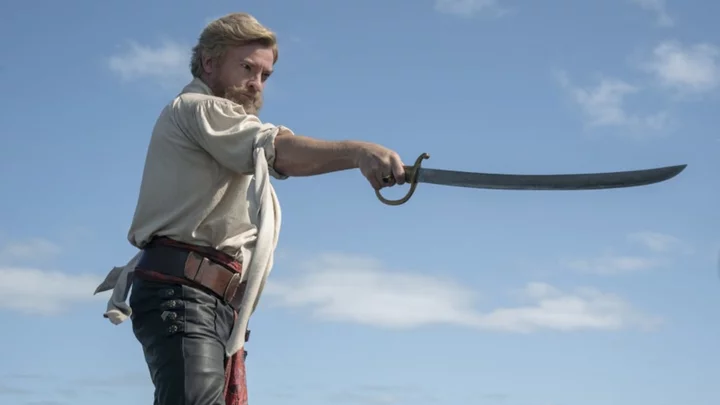Stede Bonnet’s brief but spectacular career as a pirate came to an end in late September of 1718, when he surrendered to South Carolina authorities after a six-hour battle at sea. The notorious criminal was far from your typical buccaneer.
Born to wealthy plantation owners in Barbados, Bonnet was well-educated and had a wife and children back home, who knew very little about his misdeeds. This unusual background had earned him the nickname “the Gentleman Pirate,” although prosecutors argued there was nothing gentlemanly about the murders and theft he had committed over a two-year period. Soon after his capture, Bonnet was sentenced to death by hanging at the Old Exchange and Provost Dungeon in Charleston, which he allegedly haunts to this day.
Bonnet has lived on through numerous pop culture depictions, ranging from the 1941 film The Devil and Daniel Webster to the video game Assassin’s Creed IV: Black Flag. Most recently, he’s taken a starring role in the Max pirate show Our Flag Means Death. Rhys Darby plays the infamous pirate, who learns much about life on the high seas from the equally infamous Blackbeard (Taika Waititi). The series casts them in an unambiguous romance, picking up a long-standing point of speculation and fascination among historians of the so-called Golden Age of Piracy, which lasted roughly from 1650 to 1720.
A Pirate’s Life
Bonnet was born in 1688 in Bridgetown, the capital city of Barbados. His colonist parents owned a plantation, which they passed on to their son upon their deaths. He married into another planter family through his 1709 wedding to Mary Allamby and the couple had four children. Three of them were still living when Bonnet bought a giant sloop he named the Revenge then left Barbados—and his family—behind.
Bonnet’s decision was a mystery to those who knew him, and is still hotly debated to this day. According to historian Lindley S. Butler, many Barbadians at the time concluded that he was mentally ill. Some scholars speculate that Bonnet may have been seeking even greater riches, or that he was fleeing an unhappy marriage. The life of a roving pirate may have afforded him a freedom to pursue relationships with other men he didn’t have on land. What is known is that Bonnet had a policy of taking only male prisoners; “women were neither needed nor wanted aboard his ship,“ writes B. R. Burg in Sodomy and the Pirate Tradition. This no-women rule was one Bonnet stole from his mentor Blackbeard, also known as Edward Teach.
Blackbeard’s Betrayal
The pair first crossed paths in 1717 in the Bahamas, where Bonnet was recovering from a damaging encounter with a Spanish warship. The Gentleman Pirate, still fairly new to the trade, handed over the reins of the Revenge to Blackbeard while he recovered from his injuries.
The new captain got to work, robbing 11 vessels in the Delaware Bay that October and expanding his fleet with a 14-gun warship he dubbed the Queen Anne’s Revenge in November. It was around this time that Bonnet was spotted aboard Blackbeard’s ship; the Boston News Letter observed he “has no command, he walks about in his morning gown, and then to his books of which he has a good library onboard.”
Despite his apparent ease with taking on the role of passenger, Bonnet reclaimed his ship that winter, bidding Blackbeard farewell. When the pirates reunited the following spring through a random encounter in the Spanish Main, Bonnet once again entrusted Blackbeard with command of his ship. This turned out to be a horrible mistake: After plundering ships along the Carolinas, Blackbeard ran off with the loot, leaving Bonnet’s vessel bare and his remaining crew stranded.
In an ironic twist, Blackbeard had pulled off this bait-and-switch while Bonnet was seeking a royal pardon from the governor of North Carolina. He had apparently intended to leave piracy behind, but after his mentor’s treachery, he returned to looting to recoup his losses, taking on the aliases Captain Edwards and Captain Thomas. The Revenge was likewise rechristened the Royal James.
Crime and Punishment
The Royal James stole tobacco, rum, molasses, and Black people from “no less than 13 vessels,” according to court documents, before the law caught up with it. Upon his surrender, Bonnet was imprisoned in Charleston, escaping at least once before his trial.
In mounting his defense, Bonnet tried to lean on the perception that he was a passenger, not a leader, telling the court that “I often told [my crew], if they did not leave off committing such Robberies, I would leave the Sloop; and desired them to put me on shore.” But this argument fell flat. The judge actually found it more galling that “a Gentleman that have had the Advantage of a liberal Education, and being generally esteemed a Man of Letters” would commit such crimes.
Bonnet was sentenced to death on November 12, 1718. Records indicate he was executed the following month.
Centuries later, the Gentleman Pirate’s motivations and actual aptitude for piracy remain unclear. But he still managed to make the history books—in his nightgown, no less.
This article was originally published on www.mentalfloss.com as Stede Bonnet, the Real-Life ’Gentleman’ Pirate Who Inspired ’Our Flag Means Death’.









